|
Gundia river basin is situated along the narrow belt of unique evergreen and semi-evergreen climax and potentially related forests (Figure 1.1), which is of two categories Dipterocarpus indicus – Kingiodendron pinnatum- Humboldia brunonis type of low elevation (0-850 m elevation) and Mesua ferrea – Palacuim ellipticum type of medium elevation (650-1400 m). This river basin area constitutes one of the prime centers of biodiversity in the Western Ghats. The river basin harbours nearly 36% of plant species, 87% of amphibians, and 41% of fishes, which are endemic to Western Ghats. Considering the ecological significance and rich biodiversity, this region can be declared as an Eco-sensitive region as per sub-section (1) with clause (v) of sub-section (2) of section 3 of the Environment (Protection) Act, 1986 (29 of 1986) and clause (d) of sub-rule (3) of rule 5 of the Environment (Protection) Rules, 1986 in concurrence with the provisions of the Indian Forests Act, 1927 (16 of 1927) and Forest (Conservation) Act, 1980 (69 of 1980) the Wildlife (Protection) Act, 1972 (53 of 1972) and also Biological diversity act 2002.
This study re-affirms ‘hottest hotspot’ status of the Western Ghats, a repository of biological wealth of rare kind, both in its aquatic and terrestrial ecosystems and indicates strongly the need for adoption of holistic eco-system management for conservation of particularly the rare and endemic fauna of the Western Ghats. The premium should be on conservation of the remaining evergreen and semi-evergreen forests, which are vital for the water security (perenniality of streams) and food security (sustenance of biodiversity). Through appropriate management there still exists a chance to restore the lost natural evergreen to semi-evergreen forests.
The Biodiversity or the Biological diversity refers to the different genera and species of organisms present in an area. The degree of species diversity varies from one ecosystem to the other. India is a very rich country in terms of the rich flora and fauna present in the natural ecosystems. The presence of different kinds of forests, variability in climatic conditions, rainfall, topography are main reasons for presence of such vast biodiversity in this country. However, due to various reasons such as climate change, increasing urbanization, industrialization, encroachment, etc. the Biodiversity is facing a major threat in many parts of the world. So, to raise public awareness in this regard and enhance the participation of people in saving the biodiversity, the United Nations General Assembly has declared the year 2010 as ‘International Year of Biodiversity’. This declaration is aimed at carrying out various activities to increase awareness and to involve people, organizations and Governments from all backgrounds for conservation of biodiversity.
The Western Ghats, is a chain of mountains, stretching north south along the western peninsular India for about 1,600 km, harbours rich flora and fauna is one among 34 global biodiversity hotspots (Myers, et al., 2000, Sreekantha et al., 2007). Various forest types such as tropical evergreen, semi-evergreen, moist and dry deciduous and high altitude sholas mingle with natural and manmade grasslands, savannas and scrub, in addition to, agriculture, plantation crops, tree monocultures, river valley projects, mining areas and many other land-uses. Over 4,000 species of flowering plants (38% endemics), 330 butterflies (11% endemics), 289 fishes (41% endemics), 135 amphibians (75% endemics), 156 reptiles (62% endemics), 508 birds (4% endemics) and 120 mammals (12% endemics) are among the known biodiversity of the Western Ghats (Daniels, 2003., Dahanukar et al., 2004., Gururaja, 2004., Sreekantha et al., 2007). Table 2.1 lists the number of organisms found in Western Ghats with their endemism status.
Table 2.1. Organisms of Western Ghats with their endemism percentage.
| Group |
Total |
Endemic Species |
% Endemism |
| Angiosperm |
4000 |
1500 |
38 |
| Butterflies |
330 |
37 |
11 |
| Fishes |
289 |
118 |
41 |
| Amphibians |
135 |
101 |
75 |
| Reptiles |
156 |
97 |
62 |
| Birds |
508 |
19 |
4 |
| Mammals |
120 |
14 |
12 |
This rich biodiversity coupled with higher endemism could be attributed to the humid tropical climate, topographical and geological characteristics, and geographical isolation (Arabian Sea to the west and the semiarid Deccan Plateau to the east). The Western Ghats forms an important watershed for the entire peninsular India, being the source of 37 west flowing rivers and three major east flowing rivers and their numerous tributaries. The stretch of Central Western Ghats of Karnataka, from 12°N to 14°N, from Coorg district to the south of Uttara Kannada district, and covering the Western portions of Hassan, Chikmagalore and Shimoga districts, is exceptionally rich in flora and fauna. Whereas the elevation from 400 m to 800 m, is covered with evergreen to semi-evergreen climax forests and their various stages of degradation, especially around human habitations, the higher altitudes, rising up to 1700 m, are covered with evergreen forests especially along stream courses and rich grasslands in between. This portion of Karnataka Western Ghats is extremely important agriculturally and horticulturally. Whereas the rice fields in valleys are irrigated with numerous perennial streams from forested hill-slopes the undulating landscape is used to great extent for growing precious cash crops, especially coffee and cardamom. Black pepper, ginger, arecanut, coconut, rubber are notable crops here, in addition to various fruit trees and vegetables. Some of the higher altitudes are under cultivation of tea. From the point of productivity, revenue generation, employment potential and subsistence the central Western Ghats are extremely important.
The landscape everywhere is mosaic of natural and man-modified elements with high diversity of flora and fauna with high degree of Western Ghat endemism. The presence of National Parks (Nagarahole and Kudremukh) and wildlife sanctuaries such as Brahmagiri and Pushpagiri, Mookambiga. Shettihalli and Sharavathi, many waterfalls and exquisite scenic locations are great draws for tourism, which stand to gain much more importance in the near future. The Gundia basin, despite teeming with human activities, related mainly to agriculture and plantations, is very rich in plant diversity. As our study is of preliminary nature we place no claim on its exhaustiveness, but hold the strong view that the region needs more careful and intensive investigations before harping on any major developmental interventions which can upset the structure and harmony of the entire network of ecosystems. A list of trees of the region, actually found during our brief field visit is given in the Table 2.2. The landscape is rich in shrubs and climbers (Table 2.3), herbs (Table 2.4) and Pteridophytes (Table 2.5)
The Gundia region is also equally important in terms of fauna present here. Our preliminary survey also included the records of various faunal species present in this region. The region is very rich in terms of butterflies (Table 2.6), dragonflies and damselflies (Table 2.7), fishes (Table 2.8), amphibians (Table 2.9), reptiles (Table 2.10), birds (Table 2.11) and mammals (Table 2.12).
Vegetation of Gundia Region:
Vegetation: The survey yielded the presence of total 239 plant species in the region out d of which 119 are trees belonging to 88 genera and 42 families, 63 are shrubs and climbers belonging to 53 genera and 34 families and 57 are herbs belonging to 49 genera and 28 families. Herbs also included orchids such as Flinkingeria nodosa, Dendrobium aquem, Trias stoksii, etc. Endemic species such as Holigarna grahmii, H.arnottiana, Myristica dactyloides, Vateria Indica, Gordonia obtuse, Canarium strictum, Artocarpus hirsutus etc., were found in most of the localities. The region inherits luxuriant forests (Figure 2.1), which can be divided broadly into the following types:
- Tropical wet evergreen to semi-evergreen rain forests: These were extensively found in most of the studied areas with a minimum to various amounts of disturbances. The canopy trees in these forests were over 30 m tall and covered with innumerable climbers and epiphytes. The tallest evergreens exceeding 30 m in height include Dipterocarpus indicus, Vateria indica, Bischofiajavanica, Calophyllum tomentosum, Elaeocarpus tuberculatus, Diospyros spp., Holigarna spp., Mangifera indica, Lophopetalum wightianum, Syzygium spp., Polyalthia fragrans, Mesua ferrea etc. These emergent trees are followed by canopy species attaining 20-25 m in height. Notable species in this strata are Canarium strictum, Cinnamomum macrocarpum, Dimocarpus longan, Fahrenhetia zeylanica, Garcinia gummi-gutta, G. Morella, Litzea spp., Myristica dactyloides, M. malabarica, etc. Still beneath are trees of lesser stature such as Mallotus tetracoccus, Nothopegia racemosa, Vepris bilocularis. The evergreen forests are rich in palms such as Arenga wigthii, Caryota urens and Pinanga dicksonii in addition to the straggler palms of Calamus spp. (canes).
- The riparian vegetation: Along the streams and rivulets, species such as Carallia brachiata, Madhuca neriifolia, Euonymus indica, Vateria indica, Calophyllum apetalum, Eleocarpus tuberculatus, etc. were found. In many places stream banks were dominated by reeds such as Cyperus pangorie, Ochlandra scriptoria, etc. Herbs such as Cryptocoryne retrospiralis, Dichanthium huegeli, Rotula aquatica, covered the sandy banks. Homonea riparia, Osmunda regalis, occurs scattered along the stream flow. Cyathea gigantea, occurs in shaded parts of the streams. Balanophora fungosa occurs as a root parasite on plants such as Euonymus indica, Syzygium sp, etc.
- Tropical wet deciduous forests: Occurred along more disturbed areas with species such as Careya arborea, Mallotus tetracoccus, Mallotus philippensis, Celtis sp., Aporosa lindleyana, Lagerstroemia lanceolate, Terminalia paniculata, etc.
- Scrub jungles: Most of the places surrounding the hilltops were scrub jungles with species such as Phyllanthus emblica, Careya arborea, Terminalia bellirica, etc.
- Grasslands and savannas: Most of the hilltops were grasslands with scattered shrubs of Wendlandia thyrusoide, Venguria spinosa, Canthium parviflorus, etc. Small stunted trees have orchids such as Trias stocksii, species of Oberonia, Dendrobium, etc.
- Scattered trees along plantations and abandoned fields: Large areas of land are being under this type with many native lopped evergreen species standing scattered along the coffee plantations as shades for coffee plants.
The heavy rainfall exceeding 5000 mm in most places favor the growth of tropical evergreen forests. As the region is suitable for cash crops and rice much lands have been brought under them after clearing forests partially or entirely, the latter for especially rice and ginger. Partial clearances are for cardamom and coffee which are the most important crops in the basin. Enmeshed in the hilly landscape are evergreen to semi-evergreen forests, scrub and secondary woodlands. The latter two types obviously are regrowth on past shifting cultivation sites as is evident from place names such as Kanchan-kumri, Yeda-kumri, Betta-kumri etc, the appellation ‘kumri’ denoting slash and burn cultivation that was prevalent in Karnataka Western Ghats in the past. To this day many of these kumri areas are having savanna, woodland or scrub vegetation if they are closer to human habitation or under successional forests, in late secondary stages dominated by evergreens. The presence of fire tolerant deciduous species such as Careya arborea, Catunaragam spinosa, Dillenia pentagyna, Grewia tilifolia, Terminalia paniculata, Bridelia stipularis and Xylia xylocarpa as well as the dominance of certain evergreens like Glochidion spp., Celtis cinnamomea, Olea dioica etc. indicate some alterations of the forests in the past.
On the contrary, interspersed and dominating the landscape are tall evergreen trees in large patches as in Bisle Ghat, Kaginahare forest, Mallalli waterfalls gorge, Yethinahole forest etc. These have high degree of Western Ghats endemism both among the trees as well as among the ground vegetation. The tallest evergreens exceeding 30 m in height include Dipterocarpus indicus, Vateria indica, Bischofiajavanica, Calophyllum tomentosum, Elaeocarpus tuberculatus, Diospyros spp., Holigarna spp., Mangifera indica, Lophopetalum wightianum, Syzygium spp., Polyalthia fragrans, Mesua ferrea etc. These emergent trees are followed by canopy species attaining 20-25 m in height. Notable species in this strata are Canarium strictum, Cinnamomum macrocarpum, Dimocarpus longan, Fahrenhetia zeylanica, Garcinia gummi-gutta, G. Morella, Litzea spp., Myristica dactyloides, M. malabarica, etc. Still beneath are trees of lesser stature such as Mallotus tetracoccus, Nothopegia racemosa, Vepris bilocularis. The evergreen forests are rich in palms such as Arenga wigthii, Caryota urens and Pinanga dicksonii in addition to the straggler palms of Calamus spp. (canes). The ground is carpeted with various herbs and shrubs, of which Strobilanthus heyneanus is prominent at the time of our visit. The gregarious species is in flowers throughout the central Western Ghats. The massive flowering, once in many years, is said to boost honey production. Pinanga dicksonii, Cyathea spp. (tree fern), Dipterocarpus indicus, Vateria indica and associate species are indicative of climax status of many forest patches. The reed Ochlandra scriptora is common along the streams and river banks. It, along with Caryota urens form important fodder for elephants.
The grasslands are widespread in the region and supports rich fauna of grazing animals. They constitute major grazing resources for the local livestock. Many of the grasslands catch fire during summer months, often set on by local people, for promoting flush of tender shoots during the growing season. In the absence of fire the grasslands might revert to forests. Notable of the grasses are Centotheca spp., Dichanthium spp., Eragrostis spp., Heteropogon contortus, Ischemum spp., Paspalum scrobiculatum etc.In addition to grasses are found various herbs such as several species of sedges like Canscora decurrens, Curculigo orchioides, Impatiens spp. (balsams), Leucas spp., Lindernia spp., Polygonum spp. and Sonerilla rheedeii. Several ground orchids like Habenaria spp., Platanthera susanne, Trias sp. etc also occur in the grasslands.
Figure 2.1: Biological richness of the Gundya basin
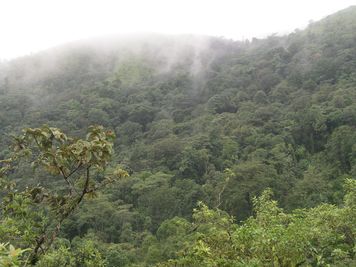
Bettakumri forest –area for submergence
|
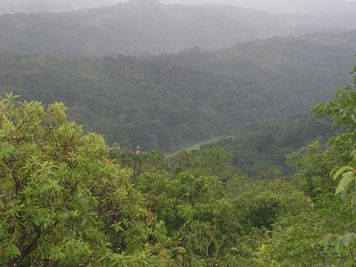
Hongadahalla: proposed to be dammed
|
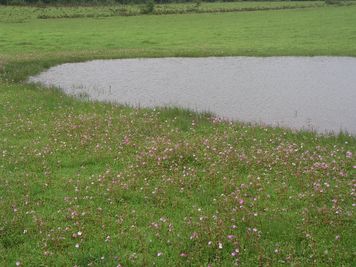
Kagneri meadow and wetland |
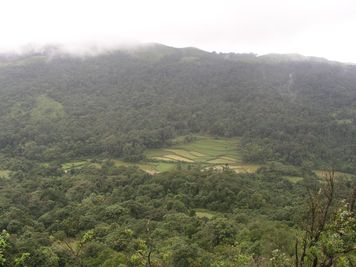
Sunkeri village –proposed submergence area under Bettakumri dam |
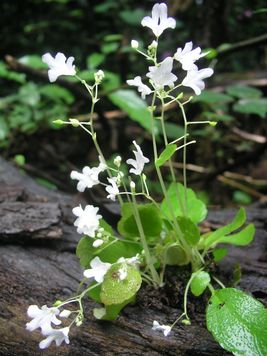
Impatiens stocksii: endemic herb
|
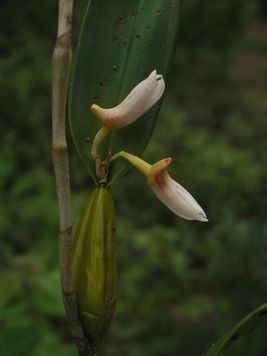
Flickingeria nodosa: endemic orchid
|
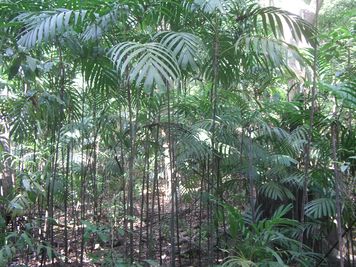
Pinanga dicksonii: Endemic palm of primary forest – Kaginara forest
|
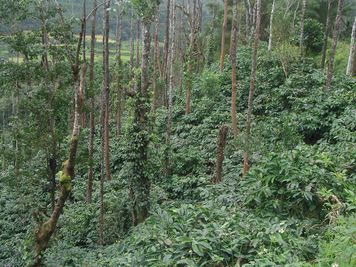
A tree clad coffee cum cardamom estate
|
The region is also rich in cardamom and coffee plantations (Figure 2.1). The cardamom plantations may be considered most eco-friendly among the lot of planting activities by humans. These are virtually evergreen forests with most of the trees preserved to favour the shade and humidity loving cardamom herbs beneath. The Gundia basin is also rich in cardamom cultivation. This cash crop fetches high returns while also preserving the forests and watershed. Both small and big farmers of Gundia basin are engaged in cardamom cultivation, the dried fruit per kilogram fetches almost around Rs.1500/- The role of cardamom plantations in preserving native vegetation has seldom been ever highlighted. The coffee estates, both small and big, like rest of central Western Ghats, constitute a major activity in the focal region. In preservation of native forest vegetation coffee is next in importance only to cardamom. In many large private holdings portions of the property are under wild vegetation. These private forests, in combination with the tree rich cardamom and coffee estates and state reserved forests make the region rich in wildlife composed of amphibians, reptiles, birds and mammals.
Gundia region is also a rich storehouse of large number of pteridophytes. A total of 54 different pteridophytic species belonging to 20 families are present in this region (Table 2.5). Three species namely Selaginella radicata Hook and Grev., Bolbitis subcrenata (Benth & Hook.)var. prolifera (Rev.) and Bolbitis semicordata (Bak.) Ching are endemic to South India. Pteridophytes form a conspicuous part of earth’s vegetation. They are an important group of plants from phylogenetic and evolutionary point of view as they show evolution of vascular plants and point out the processes that led to development of seed habit in plants. They provide a link between lower non-vascular and higher vascular group of plants. Many of them act as biological indicators also. Their habitat consists of microclimatic conditions with special preference for moist and shady places. A minor disturbance in their microclimate conditions can lead to loss of large number of species. A list of trees of the region, actually found during our brief field visit is given in the Table 2.2. The landscape is rich in shrubs and climbers (Table 2.3), herbs (Table 2.4) and Pteridophytes (Table 2.5).
Table 2.2: Trees of Gundia region
| Sl |
Family |
Genera |
Species |
Distribution |
| 1 |
Lauraceae |
Actinodaphne |
hookeri |
Western Ghats |
| 2 |
Meliaceae |
Aglaia |
anamalayana |
Western Ghats |
| 3 |
Meliaceae |
Aglaia |
roxbhurgii |
|
| 4 |
Simaroubaceae |
Ailanthus |
excelsa |
|
| 5 |
Fabaceae |
Albizzia |
sp |
|
| 6 |
Apocynaceae |
Alstonia |
scholaris |
|
| 7 |
Rubiaceae |
Anthocephallus |
cadamba |
|
| 8 |
Euphorbiaceae |
Antidesma |
menasu |
Western Ghats |
| 9 |
Euphorbiaceae |
Aporosa |
lindleyana |
|
| 10 |
Moraceae |
Artocarpus |
heterophyllus |
Western Ghats |
| 11 |
Moraceae |
Artocarpus |
hirsuta |
Western Ghats |
| 12 |
Moraceae |
Artocarpus |
gomezianus |
Western Ghats, Sri Lanka |
| 13 |
Fabaceae |
Bauhinia |
sp |
|
| 14 |
Lauraceae |
Beilsmedia |
fagifolia |
|
| 15 |
Euphorbiaceae |
Bischofia |
javanica |
|
| 16 |
Bombacaceae |
Bombax |
ceiba |
|
| 17 |
Euphorbiaceae |
Bridelia |
crenulata |
Peninsular India |
| 18 |
Fabaceae |
Butea |
monosperma |
|
| 19 |
Verbenaceae |
Callicarpa |
tomentosa |
South India |
| 20 |
Clusiaceae |
Calophyllum |
apetalum |
Western Ghats |
| 21 |
Clusiaceae |
Calophyllum |
polyanthum |
|
| 22 |
Burseraceae |
Canarium |
strictum |
|
| 23 |
Rubiaceae |
Canthium |
dicoccum |
|
| 24 |
Rhizophoraceae |
Carallia |
brachiata |
|
| 25 |
Lecythidaceae |
Careya |
arborea |
|
| 26 |
Arecaceae |
Caryota |
urens |
|
| 27 |
Ulmaceae |
Celtis |
cinnamomea |
|
| 28 |
Sapotaceae |
Chrysophyllum |
roxburghii |
Western Ghats |
| 29 |
Lauraceae |
Cinnamomum |
macrocarpum |
Western Ghats |
| 30 |
Lauraceae |
Cinnamomum |
zeylanicum |
Western Ghats, Sri Lanka |
| 31 |
Arecaceae |
Corypha |
umbreculifera |
Western Ghats, Sri Lanka |
| 32 |
Dillleniaceae |
Dillenia |
pentagyna |
|
| 33 |
Sapindaceae |
Dimocarpus |
longan |
|
| 34 |
Ebenaceae |
Diospyros |
candolleana |
Western Ghats |
| 35 |
Ebenaceae |
Diospyros |
crumenata |
Western Ghats, Sri Lanka |
| 36 |
Ebenaceae |
Diospyros |
montana |
|
| 37 |
Ebenaceae |
Diospyros |
assymilis |
Western Ghats |
| 38 |
Ebenaceae |
Diospyros |
nigrescens |
Western Ghats |
| 39 |
Dipterocarpaceae |
Dipterocarpus |
indicus |
Western Ghats |
| 40 |
Meliaceae |
Dysoxylum |
binectariferum |
Western Ghats, Sri Lanka |
| 41 |
Elaeocarpaceae |
Elaeocarpus |
serratus |
India, Sri Lanka |
| 42 |
Elaeocarpaceae |
Elaeocarpus |
tuberculatus |
|
| 43 |
Apocynaceae |
Ervatamia |
heyneana |
Western Ghats |
| 44 |
Celastraceae |
Euonymus |
indicus |
Western Ghats |
| 45 |
Euphorbiaceae |
Fahrenheitia |
zeylanica |
Western Ghats, Sri Lanka |
| 46 |
Moraceae |
Ficus |
arnottiana |
India, Sri Lanka |
| 47 |
Moraceae |
Ficus |
tsjahela |
South India, Sri Lanka |
| 48 |
Moraceae |
Ficus |
hispida |
|
| 49 |
Moraceae |
Ficus |
sp. |
|
| 50 |
Flacourtiaceae |
Flacourtia |
montana |
Western Ghats |
| 51 |
Clusiaceae |
Garcinia |
gummi-gutta |
Western Ghats |
| 52 |
Clusiaceae |
Garcinia |
morella |
|
| 53 |
Clusiaceae |
Garcinia |
talbotii |
Western Ghats |
| 54 |
Clusiaceae |
Garcinia |
xanthochymus |
|
| 55 |
Euphorbiaceae |
Glochidion |
johnstonei |
Western Ghats |
| 56 |
Euphorbiaceae |
Glochidion sp |
|
|
| 57 |
Verbenaceae |
Gmelina |
arborea |
|
| 58 |
Theaceae |
Gordonia |
obtusa |
Western Ghats |
| 59 |
Tiliaceae |
Grewia |
tiliaefolia |
|
| 60 |
Anacardiaceae |
Holigarna |
arnotiana |
Western Ghats |
| 61 |
Anacardiaceae |
Holigarna |
grahamii |
Western Ghats |
| 62 |
Anacardiaceae |
Holigarna |
beddomii |
Western Ghats |
| 63 |
Anacardiaceae |
Holigarna |
ferruginia |
Western Ghats |
| 64 |
Dipterocarpaceae |
Hopea |
ponga |
Western Ghats |
| 65 |
Flacourtiaceae |
Hydnocarpus |
laurifolia |
Western Ghats |
| 66 |
Rubiaceae |
Ixora |
arborea |
Western Ghats |
| 67 |
Myristicaceae |
Knema |
attenuata |
Western Ghats |
| 68 |
Lythraceae |
Lagerstroemia |
microcarpa |
Western Ghats |
| 69 |
Oleaceae |
Ligustrum |
neilgherrensis |
|
| 70 |
Oleaceae |
Linoceira |
malabarica |
Western Ghats |
| 71 |
Lauraceae |
Litsea |
floribunda |
Western Ghats |
| 72 |
Lauraceae |
Litsea |
sp |
|
| 73 |
Celastraceae |
Lophopetalum |
wightianum |
|
| 74 |
Euphorbiaceae |
Macaranga |
peltata |
Western Ghats, Sri Lanka |
| 75 |
Sapotaceae |
Madhuca |
neriifolia |
Western Ghats, Sri Lanka |
| 76 |
Euphorbiaceae |
Mallotus |
philippensis |
|
| 77 |
Euphorbiaceae |
Mallotus |
tetracoccus |
|
| 78 |
Anacardiaceae |
Mangifera |
indica |
|
| 79 |
Anacardiaceae |
Mastixia |
arborea |
Western Ghats |
| 80 |
Annonaceae |
Meiogyne |
ramarowii |
South India |
| 81 |
Melastomaceae |
Memycelon |
malabarica |
Western Ghats |
| 82 |
Melastomaceae |
Memycelon |
umbellatum |
|
| 83 |
Clusiaceae |
Mesua |
ferrea |
|
| 84 |
Sapotaceae |
Mimusops |
elengi |
|
| 85 |
Myristicaceae |
Myristica |
dactyloides |
South India, Sri Lanka |
| 86 |
Rubiaceae |
Neonauclea |
purpurea |
Western Ghats |
| 87 |
Anacardiaceae |
Nothopegia |
colebrookeana |
Western Ghats |
| 88 |
Icacinaceae |
Nothopodytes |
foetida |
|
| 89 |
Oleaceae |
Olea |
dioica |
Western Ghats, Deccan plateau |
| 90 |
Sapotaceae |
Palaquium |
ellipticum |
Western Ghats |
| 91 |
Lauraceae |
Persea |
macrantha |
Peninsular India, Sri Lanka |
| 92 |
Euphorbiaceae |
Phyllanthus |
emblica |
|
| 93 |
Fabaceae |
Pithecellobium |
monadelphum |
India |
| 94 |
Pittosporaceae |
Pittosporum |
dasycaulon |
Western Ghats |
| 95 |
Annonaceae |
Polyaltha |
fragrans |
Western Ghats |
| 96 |
Fabaceae |
Pongamia |
pinnata |
|
| 97 |
Sterculiaceae |
Pterospermum |
diversifolium |
|
| 98 |
Sterculiaceae |
Pterospermum |
reticulatum |
|
| 99 |
Rubiaceae |
Randia |
dumetorum |
|
| 100 |
Bombacaceae |
Salmalia |
malabarica |
|
| 101 |
Sterculiaceae |
Sterculia |
guttata |
Western Ghats, Sri Lanka |
| 102 |
Bignoniaceae |
Steriospermum |
personatum |
|
| 103 |
Symplocaceae |
Symplocos |
racemosa |
Western Ghats |
| 104 |
Symplocaceae |
Symplocos |
cochinchinensis |
|
| 105 |
Myrtaceae |
Syzygium |
laetum |
Western Ghats |
| 106 |
Myrtaceae |
Syzygium |
gardneri |
Western Ghats, Sri Lanka |
| 107 |
Myrtaceae |
Syzygium |
cumini |
|
| 108 |
Myrtaceae |
Syzygium |
sp |
|
| 109 |
Verbenaceae |
Tectona |
grandis |
|
| 110 |
Combretaceae |
Terminalia |
paniculata |
India |
| 111 |
Combretaceae |
Terminalia |
bellirica |
|
| 112 |
Ulmaceae |
Trema |
orientalis |
|
| 113 |
Euphorbiaceae |
Trewia |
nudiflora |
|
| 114 |
Dipterocarpaceae |
Vateria |
indica |
Western Ghats |
| 115 |
Rutaceae |
Vepris |
bilocularis |
Western Ghats |
| 116 |
Verbenaceae |
Vitex |
altissima |
South India |
| 117 |
Rubiaceae |
Wendlandia |
thyrsoidea |
South India, Sri Lanka |
| 118 |
Fabaceae |
Xylia |
xylocarpa |
|
| 119 |
Rutaceae |
Zanthoxylum |
rhetsa |
|
Table 2.3: Shrubs and climbers of Gundia region
| Sl |
Family |
Genera |
Species |
Distribution |
| 1 |
Sapindaceae |
Allophylus |
cobbe |
|
| 2 |
Menispermaceae |
Anamirta |
cocculus |
|
| 3 |
Ancistrocladaceae |
Ancistrocladus |
heyneanus |
Western Ghats |
| 4 |
Aristolochiaceae |
Apama |
siliqosa |
Western Ghats, Sri Lanka |
| 5 |
Myrsinaceae |
Ardisia |
solanacea |
India |
| 6 |
Arecaceae |
Arenga |
wightii |
Western Ghats |
| 7 |
Liliaceae |
Asparagus |
racemosa |
|
| 8 |
Rutaceae |
Atalantia |
racemosa |
|
| 9 |
Poaceae |
Bambusa |
arundinacea |
Oriental-India |
| 10 |
Acanthaceae |
Barleria |
courtillica |
|
| 11 |
Fabaceae |
Bauhinia |
phoenicea |
Western Ghats |
| 12 |
Euphorbiaceae |
Blachia |
sp |
|
| 13 |
Euphorbiaceae |
Breynia |
retusa |
India, Sri Lanka |
| 14 |
Arecaceae |
Calamus |
thwaitesii |
Western Ghats |
| 15 |
Arecaceae |
Calamus |
sp |
|
| 16 |
Verbenaceae |
Callicarpa |
tomentosa |
South India |
| 17 |
Rubiaceae |
Canthium |
parviflorum |
|
| 18 |
Arecaceae |
Caryota |
urens |
|
| 19 |
Rubiaceae |
Chasalia |
ophioxyloides |
South India, Sri Lanka |
| 20 |
Lamiaceae |
Colebrookea |
oppositifolia |
|
| 22 |
Fabaceae |
Dalbergia |
horrida |
|
| 23 |
Fabaceae |
Dalbergia |
sp |
|
| 24 |
Fabaceae |
Dalbergia |
sympethetica |
Western Ghats |
| 25 |
Elaeagnaceae |
Elaeagnus |
latifolia |
|
| 26 |
Myrsinaceae |
Embelia |
tjeriam-cottam |
|
| 27 |
Rhamnaceae |
Gaunia |
microcarpa |
|
| 28 |
Gnetaceae |
Gnetum |
ula |
South India |
| 29 |
Malvaceae |
Hibiscus |
furcatus |
|
| 30 |
Apocynaceae |
Holarrhena |
antidysenterica |
|
| 31 |
Euphorbiaceae |
Homonea |
riparia |
|
| 32 |
Rubiaceae |
Ixora |
brachiata |
|
| 33 |
Rubiaceae |
Ixora |
sp |
|
| 34 |
Acanthaceae |
Justicia |
montana |
|
| 35 |
Leeaceae |
Leea |
indica |
|
| 36 |
Oleaceae |
Ligustrum |
gamblei |
Western Ghats |
| 37 |
Campanulaceae |
Lobelia |
nicotianifolia |
Western Ghats, Sri Lanka |
| 38 |
Melastomaceae |
Melastoma |
malabathricum |
India |
| 39 |
Melastomataceae |
Memycelon |
terminale |
Western Ghats |
| 40 |
Fabaceae |
Mucuna |
sp |
|
| 41 |
Rubiaceae |
Mussaenda |
laxa |
Western Ghats |
| 42 |
Icacinaceae |
Nothopodytes |
nimmoniana |
|
| 43 |
Poaceae |
Ochlandra |
scriptoria |
Western Ghats |
| 44 |
Pandanaceae |
Pandanus |
sp |
|
| 45. |
Arecaceae |
Pinanga |
dicksonii |
Western Ghats |
| 46 |
Arecaceae |
Phoenix |
humilis |
Western Ghats |
| 47 |
Araceae |
Pothos |
scandens |
|
| 48 |
Urticaceae |
Pouzolzia |
wightii |
|
| 49 |
Rubiaceae |
Psychotria |
dalzellii |
Western Ghats |
| 50 |
Rubiaceae |
Psychotria |
flavida |
Western Ghats |
| 51 |
Rubiaceae |
Psychotria |
truncata |
Western Ghats |
| 52 |
Araceae |
Rhaphidophora |
laciniata |
Western Ghats, Sri Lanka |
| 53 |
Rubiaceae |
Rubia |
cordifolia |
|
| 54 |
Rosaceae |
Rubus |
fockei |
Western Ghats |
| 55 |
Marantaceae |
Schumannianthus |
virgatus |
South India, Sri Lanka |
| 56 |
Smilacaceae |
Smilax |
zeylanica |
|
| 57 |
Solanaceae |
Solanum |
sp |
|
| 58 |
Acanthaceae |
Strobilanthus |
heyneanus |
Western Ghats |
| 59 |
Acanthaceae |
Strobilanthus |
barbatus |
Western Ghats |
| 60 |
Rubiaceae |
Venguria |
spinosa |
|
| 61 |
Vitaceae |
Vitaceae |
sp |
|
| 62 |
Rubiaceae |
Wendlandia |
thyrusoide |
|
| 63 |
Rhamnaceae |
Ziziphus |
rugosa |
India, Sri Lanka |
Table 2.4: Herbs of Gundia region
| Sl |
Family |
Genera |
Species |
Distribution |
| 1 |
Gesneriaceae |
Aeschynanthus |
perrottetii |
Western Ghats |
| 2 |
Zingiberaceae |
Alpinia |
malaccensis |
|
| 3 |
Poaceae |
Arundinella |
sp |
|
| 4 |
Balanophoraceae |
Balanophora |
fungosa ssp indica |
Western Ghats |
| 5 |
Gentianaceae |
Canscora |
deccurens |
|
| 6 |
Poaceae |
Centotheca |
lappacea |
|
| 7 |
Asteraceae |
Crassocephalum |
crepidiodes |
South and North East India |
| 8 |
Araceae |
Cryptocoryne |
retrospiralis |
|
| 9 |
Liliaceae |
Curculigo |
orchioides |
Western Ghats |
| 10 |
Zingiberaceae |
Curcuma |
neilgherrensis |
|
| 11 |
Cyperaceae |
Cyperus |
difformis |
|
| 12 |
Cyperaceae |
Cyperus |
iria |
|
| 13 |
Cyperaceae |
Cyperus |
pangorei |
|
| 14 |
Cyperaceae |
Cyperus |
tenuispica |
Western Ghats |
| 15 |
Orchidaceae |
Dendrobium |
aqueum |
|
| 16 |
Orchidaceae |
Dendrobium |
sp |
India |
| 17 |
Poaceae |
Dichanthium |
huegelii |
|
| 18 |
Scrophulariaceae |
Dopatrium |
junceum |
|
| 19 |
Agavaceae |
Dracaena |
ternifolia |
|
| 20 |
Poaceae |
Eragrostis |
sp |
|
| 21 |
Cyperaceae |
Fimbristylis |
aestivalis |
|
| 22 |
Cyperaceae |
Fimbristylis |
littoralis |
|
| 23 |
Fabaceae |
Flemingia |
strobilifera |
India |
| 24 |
Orchidaceae |
Flinkingeria |
nodosa |
|
| 25 |
Poaceae |
Heteropogon |
contortus |
|
| 26 |
Piperaceae |
Heckeria |
piperita |
Western Ghats |
| 27 |
Asclepiadaceae |
Hoya |
retusa |
|
| 28 |
Hydrophyllaceae |
Hydrolea |
zeylanica |
Western Ghats |
| 29 |
Balsaminaceae |
Impatiens |
stocksii |
|
| 30 |
Poaceae |
Ischemum |
sp |
|
| 31 |
Crassulaceae |
Kalanchoe |
sp |
|
| 32 |
Cyperaceae |
Kyllinga |
sp |
|
| 33 |
Araceae |
Lagenandra |
sp |
|
| 34 |
Lamiaceae |
Leucas |
sp |
|
| 35 |
Scrophulariaceae |
Lindernia |
antipoda |
|
| 36 |
Scrophulariaceae |
Lindernia |
hyssopoides |
|
| 37 |
Scrophulariaceae |
Lindernia |
rotundifolia |
|
| 38 |
Scrophulariaceae |
Lindernia |
sp |
|
| 39 |
Campanulaceae |
Lobelia |
nicotianifolia |
|
| 40 |
Onagraceae |
Ludwigia |
sp |
|
| 41 |
Nymphaceae |
Nymphaea |
nauchali |
|
| 42 |
Menyanthaceae |
Nymphoides |
indica |
|
| 43 |
Orchidaceae |
Oberonia |
sp |
|
| 44 |
Poaceae |
Paspalum |
scrobiculatum |
|
| 45 |
Orchidaceae |
Pholidota |
pallida |
|
| 46 |
Polygonaceae |
Polygonum |
sp |
|
| 47 |
Cyperaceae |
Pycreus |
polystachyos |
|
| 48 |
Boraginaceae |
Rotula |
aquatica |
|
| 49 |
Acanthaceae |
Rungia |
pectinata |
|
| 50 |
Lamiaceae |
Scutellaria |
discolor |
Western Ghats |
| 51 |
Malvaceae |
Sida |
acuta |
|
| 52 |
Melastomataceae |
Sonerila |
rheedii |
|
| 53 |
Asteraceae |
Spilanthus |
sp |
S W India |
| 54 |
Asteraceae |
Spilathus |
paniculata |
|
| 55 |
Orchidaceae |
Trias |
stocksii |
S W India, Sri Lanka |
| 56 |
Lentibulariaceae |
Utricularia |
striatula |
|
| 57 |
Orchidaceae |
Zeuxine |
longilabris |
|
Table 2.5: Pteridophytes of Gundia region
| Sl |
Botanical name |
Family |
Status |
| 1 |
Adiantum lunulatum Burm.F. |
Adiantaceae |
|
| 2 |
Adiantum capillus-veneris L. |
Adiantaceae |
|
| 3 |
Angiopteris evecta (Forst.) Hoff. |
Angiopteridaceae |
|
| 4 |
Asplenium indicum Sledge |
Aspleniaceae |
|
| 5 |
Asplenium cheilosorum Krge |
Aspleniaceae |
|
| 6 |
Asplenium crinicaule Hance |
Aspleniaceae |
|
| 7 |
Athyrium hohenackeranum Kuntz. |
Athyriaceae |
|
| 8 |
Athyrium falcatum Bedd. |
Athyriaceae |
|
| 9 |
Athyrium solenopteris Kuntz. |
Athyriaceae |
|
| 10 |
Blechnum orientale L. |
Blechnaceae |
|
| 11 |
Cyathea gigantean Holttum |
Cyatheaceae |
|
| 12 |
Araiostegia pulchra (D.Don) Copel |
Davalliaceae |
|
| 13 |
Pteridium aquilinium (L.) Kunth |
Dennstaedtiaceae |
|
| 14 |
Microlepia speluncae (L.) Moore |
Dennstaedtiaceae |
|
| 15 |
Arachniodes cordifolia Moore |
Dryopteridaceae |
|
| 16 |
Dryopteris chrysocema |
Dryopteridaceae |
|
| 17 |
Dryopteris cochleata D.Don |
Dryopteridaceae |
|
| 18 |
Dryopteris marginata |
Dryopteridaceae |
|
| 19 |
Bolbitis subcrenata (Benth & Hook.)var. prolifera (Rev.) |
Elaphoglossaceae |
Endemic to South India |
| 20 |
Bolbitis semicordata (Bak.) Ching |
Elaphoglossaceae |
Endemic to South India |
| 21 |
Gleichenia linearis Burm.F. |
Gleicheniaceae |
|
| 22 |
Gramites medialis (Bak) Ching |
Grammitidaceae |
|
| 23 |
Egenolphia asplenifolia (Bory) Fee |
Lomariopsidaceae |
|
| 24 |
Lycopodium hamiltonii Spreng. |
Lycopodiaceae |
|
| 25 |
Lycopodium cermum L. |
Lycopodiaceae |
|
| 26 |
Lycopodium squarrosum Forst. |
Lycopodiaceae |
|
| 27 |
Lycopodium subulifolium Wall. Ex. Hook. And Grev. |
Lycopodiaceae |
|
| 28 |
Nephrolepis multiflora (Roxb.) Jarret. |
Oleandraceae |
|
| 29 |
Nephrolepis undulata |
Oleandraceae |
|
| 30 |
Oleandra musifolia Kz. |
Oleandraceae |
|
| 31 |
Oleandra neriiformis Cav. |
Oleandraceae |
|
| 32 |
Ophioglossum nudicaule L.F. |
Ophioglossaceae |
|
| 33 |
Ophiglossum gramineum L. |
Ophioglossaceae |
Cr.En. |
| 34 |
Aleuritopteris anceps Blanf. |
Pteridaceae |
|
| 35 |
Cheilanthes farinose (Forsk) Kault |
Pteridaceae |
|
| 36 |
Cheilanthes opposita syn. Cheilanthes mysurensis |
Pteridaceae |
|
| 37 |
Doryopteris concolor |
Pteridaceae |
|
| 38 |
Lygodium microphyllum (Cav.) R.Br. |
Schizaeaceae |
|
| 39 |
Lygodium flexosum (L.) Sw. |
Schizaeaceae |
|
| 40 |
Selaginella tenera (Hook and Grev) |
Selaginellaceae |
|
| 41 |
Selaginella ciliaris (Retz) Spring |
Selaginellaceae |
|
| 42 |
Selaginella longipila Hieron |
Selaginellaceae |
|
| 43 |
Selaginella reticulate |
Selaginellaceae |
|
| 44 |
Selaginella proniflora (Lamk) Bak |
Selaginellaceae |
|
| 45 |
Selaginella radicata Hook and Grev. |
Selaginellaceae |
Endemic to South India |
| 46 |
Ampelopteris prolifera (Retz) Copel. |
Thelypteridaceae |
|
| 47 |
Amphineuron terminans (Hooker) Holftam |
Thelypteridaceae |
|
| 48 |
Christella dentata (Forsk) Brownsey and Jermy |
Thelypteridaceae |
|
| 49 |
Christella parasitica (L.) Lev. |
Thelypteridaceae |
|
| 50 |
Macrothelypteris ornate (Wall ex Bedd) |
Thelypteridaceae |
|
| 51 |
Macrothelypteris torresiana (Gaud) |
Thelypteridaceae |
|
| 52 |
Pronephrium articulatum Holttum |
Thelypteridaceae |
|
| 53 |
Pseudocyclosorus ochthodes Kuntze |
Thelypteridaceae |
|
| 54 |
Trigonospora ciliate (Benth) |
Thelypteridaceae |
|
FAUNA:
Butterflies: Forty-four species of butterflies (Table 2.6) are found in this area belonging to five families: Family Nymphalidae is dominated by 23 species followed by Lycaenidae 8 species, Pieridae 7, Papilionidae 5 species and Hesperiidae one species. Two endangered species namely Crimson rose and Danaid eggfly are found in this region emphasising the ecological significance of the region. Many species are found mud-puddling close to the streams and some species are basking in the open canopy areas.
Table 2.6: Butterflies found in Gundia region
| Sr. No. |
Scientific Name |
Common Name |
Ecological status |
| |
Family: Papilionidae |
|
|
| 1 |
Troides minos Cramer |
Southern Birdwing (PI) |
Rare |
| 2 |
Pachliopta hector L., |
Crimson Rose (PI&SL) |
Endangered |
| 3 |
Graphium sarpedon L., |
Common Bluebottle |
Common |
| 4 |
Graphium agamemnon L., |
Tailed Jay |
Common |
| 5 |
Papilio polytes L., |
Common Mormon |
common |
| |
Family: Pieridae |
|
|
| 6 |
Catopsilia pomona Fabricius |
Common Emigrant |
Common |
| 7 |
Eurema hecabe L., |
Common Grass Yellow |
Common |
| 8 |
Delias eucharis Drury |
Common Jezebel (PI & SL) |
Common |
| 9 |
Leptosia nina Fabricius |
Psyche |
common |
| 10 |
Cepora nerissa Fabricius |
Common Gull |
common |
| 11 |
Appias albina Boisduval |
Common Albatross |
Rare |
| 12 |
Hebomoea glaucippe L., |
Great Orange Tip |
Rare |
| |
Family: Nymphalidae |
|
|
| 13 |
Melanitis leda L., |
Common Evening Brown |
Common |
| 14 |
Mycalesis perseus Fabricius |
Common Bushbrown |
Rare |
| 15 |
Mycalesis patnia Moore |
Glad-eye Bushbrown (PI&SL) |
Common |
| 16 |
Ypthima asterope Klug |
Common Three-ring |
Common |
| 17 |
Cethosia nietneri C&R Felder |
Tamil Lacewing (PI&SL) |
Common |
| 18 |
Cupha erymanthis Drury |
Rustic |
Rare |
| 19 |
Polyura athamas Drury |
Common Nawab |
Common |
| 20 |
Phalanta phalantha Drury |
Common Leopard |
Common |
| 21 |
Cirrochroa thais Fabricius |
Tamil Yeoman (PI&SL) |
Common |
| 22 |
Neptis hylas Moore |
Common Sailer |
Common |
| 23 |
Pantoporia hordonia Stoll |
Common Lascar |
Common |
| 24 |
Athyma perius L., |
Common Sergeant |
Common |
| 25 |
Moduza procris Cramer |
Commander |
Common |
| 26 |
Ariadne merione Cramer |
Common Castor |
Common |
| 27 |
Junonia lemonias L., |
Lemon Pansy |
Common |
| 28 |
Junonia atlites L., |
Grey Pansy |
Common |
| 29 |
Junonia iphita Cramer |
Chocolate Pansy |
Common |
| 30 |
Hypolimnas bolina L., |
Great Eggfly |
Common |
| 31 |
Hypolimnas misippus L., |
Danaid Eggfly (PI&SL) |
Endangered |
| 32 |
Tirumala limniace Cramer |
Blue Tiger |
Common |
| 33 |
Parantica aglea Stoll |
Glassy Tiger |
Common |
| 34 |
Danaus genutia Cramer |
Striped Tiger |
Common |
| 35 |
Euploea core Cramer |
Common Indian Crow |
Common |
| 36 |
Castalius rosimon Fabricius |
Common Pierrot |
Common |
| 37 |
Actolepis puspa Horsfield |
Common Hedge Blue |
Rare |
| 38 |
Zizula hylax Fabricius |
Tiny Grass Blue |
Common |
| 39 |
Chilades laius Stoll |
Lime Blue |
Common |
| 40 |
Lampides boeticus L., |
Pea Blue |
Common |
| 41 |
Jamides celeno Cramer |
Common Cerulean |
Common |
| 42 |
Prosotas nora C & R Felder |
Common Lineblue |
Common |
| 43 |
Arhopala amantes Hewitson |
Large Oakblue |
Common |
| |
Family: Hesperiidae |
|
|
| 44 |
Hasora chromus Cramer |
Common Banded Awl |
Common |
Figure 2.2: Biodiversity of Gundia basin (Humming bird hawk moth…)
Dragons and damselflies: Four species of Odonates are found in this area (Table 2.7). The species are Clear-winged Forest glory (Vestalis gracilis), Stream ruby (Rhinocypha bisignata), Stream glory Neurobasis chinensis) and Ground skimmer (Diplocodes trivailis). The three speices are found along the streams of Hongadahalla, Battekumri halla and Kempholé whereas, the Diplocodes trivailis is found in the forest undergrowth of Hongadahalla area.
Table 2.7: Dragons and damselflies in Gundia region
| Sl.No |
Scientific Name |
Common Name |
| 1 |
Rhinocypha bisignata |
Stream Ruby |
| 2 |
Neurobasis chinensis |
Stream Glory |
| 3 |
Vestalis gracilis |
Clear-winged Forest Glory |
| 4 |
Diplocodes trivailis |
Ground Skimmer |
Fish: 56 different species of fishes were recorded from Netravathi and Kumaradhara rivers out of which 23 are endemics (Table 2.8). 11 species are assigned as Vulnerble and 8 species have been assigned as Endangered by the IUCN and feture in the Red List of Threatened species. Figure 2.3 provides the glimpse of fish habitats in Gundia river basin. Horabagrus brachysoma (Gunther) and Etroplus Canadensis are endemic species and are featured as Critically Endangered species in the Red List. Three fish species have very limited distibution and have been described here:
- Etroplus canarensis: This species was first described in 1877 - and never seen since then, and re-discovered in 1997. This is the third Cichlid species from Asia along with other two common species Etroplus maculatus and Etroplus suratensis. Unlike these two 18 species, Etroplus canarensis is purely a freshwater dweller. The species is restricted only to a short river stretch of 2-3 km of the Nethravathi River. Presently, nothing much is known about the ecology, life cycle, and evolutionary aspects of this species.
- Mahseers: Several species have been reported from India and from southern India, the Tor khudree and Tor mussullah. Mahseers prefer running water with deep pools and rocky substrate. They rule the Indian waters like tiger do the jungle. Three protected sites for fishes along downstream region of Kumaradhara and Nethravathi, indicates the fish richness of the region as well as the conservation priority given to these rivers.
- Mesonemacheilus petrubanarescui: A species, belonging to Balitoridae family has been reported from Dharmasthala of Nethravathi River and so far it has not been reported from any other region.
Table 2.8: Fishes of Nethravati and Kumaradhara rivers
| Sr. No. |
Species name |
Distribution |
IUCN Status |
| 1. |
Anguilla bengalensis (Gray) |
India |
VU |
| 2. |
Aplocheilus blocki (Arnold) |
India |
DD |
| 3. |
Aplocheilus lineatus (Val.) |
India |
LR |
| 4. |
Barilius bakeri (Day) |
Endemic |
VU |
| 5. |
Barilius canarensis (Jerdon) |
Endemic |
DD |
| 6. |
Barilius gatensis (Val.) |
Endemic |
DD |
| 7. |
Brachydanio rerio (Ham.) |
India |
LR |
| 8. |
Channa orientalis (Bl. & Schn.) |
India |
VU |
| 9. |
Channa striatus |
India |
LR |
| 10. |
Cirrhinus reba (Ham.) |
India |
VU |
| 11. |
Clarias dussumieri (Val.) |
Endemic |
VU |
| 12. |
Cyprinus carpio communis (Linne.) |
India |
Intro |
| 13. |
Danio aequipinnatus |
India |
LR |
| 14. |
Danio malabaricus (Jerdon) |
India |
LR |
| 15. |
Esomus thermoicos (Val.) |
India |
LR |
| 16 |
Etroplus canarensis |
Endemic |
CR |
| 17. |
Etroplus maculatus (Bloch) |
India |
LR |
| 18. |
Garra gotyla stenorhynchus |
Endemic |
EN |
| 19. |
Garra mullya (Sykes) |
India |
LR |
| 20. |
Glossogobius giuris |
India |
LR |
| 21. |
Horabagrus brachysoma (Gunther) |
Endemic |
CR |
| 22. |
Hyporhamphus limbatus (Val.) |
India |
DD |
| 23. |
Hypselobarbus kurali Menon and Rema Devi |
Endemic |
EN |
| 24. |
Labeo kontius (Jerdon) |
Endemic |
EN |
| 25. |
Lepidocephalus thermalis (Val.) |
India |
LR |
| 26. |
Mastacembelus armatus Lacepede |
India |
LR |
| 27. |
Mesonemacheilus petrubanarescui |
Endemic |
DD |
| 28. |
Mystus cavasius (Ham.) |
India |
LR |
| 29. |
Mystus malabaricus (Jerdon) |
Endemic |
EN |
| 30. |
Oreochromis mossambica (Peters) |
India |
Intro |
| 31. |
Osteochilichthys nashii Day |
Endemic |
VU |
| 32. |
Poecilia reticulata (Peters) |
India |
Intro |
| 33. |
Pristolepis marginata (Jerdon) |
Endemic |
VU |
| 34. |
Pseudosphromenus cupanius (Val.) |
India |
DD |
| 35. |
Puntius amphibius (Val.) |
India |
LR |
| 36. |
Puntius arulius arulius (Jerdon) |
Endemic |
EN |
| 37. |
Puntius bimaculatus (Bleeker) |
India |
DD |
| 38. |
Puntius conchonius (Ham.) |
India |
VU |
| 39. |
Puntius filamentosus (Val.) |
India |
DD |
| 40. |
Puntius melanampyx (Day) |
Endemic |
LR |
| 41. |
Puntius melanostigma (Day) |
Endemic |
EN |
| 42. |
Puntius sarana subnasutus (Val.) |
Endemic |
LR |
| 43. |
Puntius setnai Chhapgar and Sane |
Endemic |
DD |
| 44. |
Puntius sophore |
India |
LR |
| 45. |
Puntius ticto (Ham.) |
India |
LR |
| 46. |
Puntius vittatus Day |
India |
VU |
| 47. |
Rasbora daniconius (Ham.) |
India |
LR |
| 48. |
Salmostoma acinaces (Val.) |
India |
LR |
| 49. |
Salmostoma boopis (Day) |
Endemic |
LR |
| 50. |
Schistura denisonii denisonii |
India |
VU |
| 51. |
Schistura kodaguensis Menon |
Endemic |
DD |
| 52. |
Schistura nilgiriensis Menon |
Endemic |
EN |
| 53. |
Schistura semiarmatus Day |
Endemic |
VU |
| 54. |
Tetraodon (M.) tavancoricus Hora & Nair |
Endemic |
EN |
| 55. |
Tor khudree (Sykes) |
India |
VU |
| 56. |
Xenentodon cancila (Ham.) |
India |
LR |
Figure 2.3: Gundia river basin – endemic fish habitats
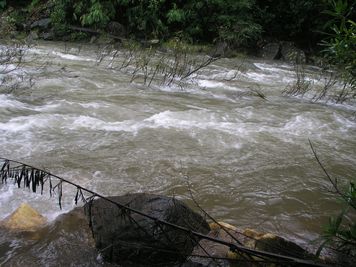
Bettakumri river- proposed to be dammed |
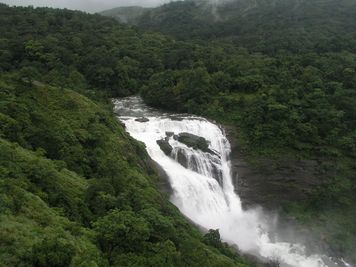
Mallalli waterfalls: the river to be blocked by weir |
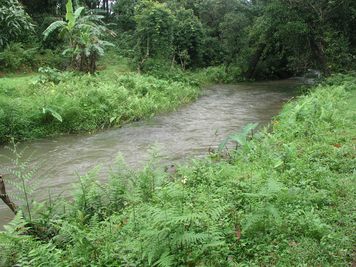
A perennial stream in Mallalli |
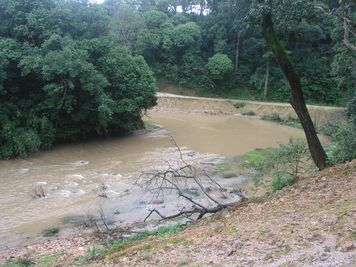
Yetinahalla dam site |
Amphibians: Amphibians are one of the best biological indicators of ecosystem health. Table 2.9 highlights the amphibians present in this area. As many as 23 species distributed in 8 families have been observed from the region. Out of these, 20 species are endemics. A critically endangered species Indirana gundia has been discovered from this region in 1986 (Figure 2.4). In the present study, two endangered species Nyctibatrachus aliciae and Minervarya sahyadris were recorded, which further highlights the ecological significance of the region. Availability of perennial sources of water has provided ample habitats for amphibians
Table 2.9: Amphibians found in Gundia basin
| Sl. |
Species |
Endemism |
Ecological status |
| |
Family: Bufonidae |
|
|
| 1 |
Bufo parietalis Boulenger, 1882 |
Endemic |
Near threatened |
| 2 |
Bufo brevirostris* Rao, 1937 |
Endemic |
|
| |
Family: Microhylidae |
|
|
| 3 |
Ramanella mormorata* Rao, 1937 |
Endemic |
Endangered |
| 4 |
Ramanella triangularis*(Günther, 1876) |
Endemic |
Vulnerable |
| 5 |
Ramanella minor* Rao, 1937 |
Endemic |
|
| |
Family: Micrixalidae |
|
|
| 6 |
Micrixalus saxicola (Jerdon, 1853) |
Endemic |
Vulnerable |
| 7 |
Micrixalus elegans* (Rao, 1937) |
Endemic |
|
| |
Family: Petropedetidae |
|
|
| 8 |
Indirana semipalmatus (Boulenger, 1882) |
Endemic |
Least concern |
| 9 |
Indirana gundia*(Dubois, 1986) |
Endemic |
Cr. Endangered |
| 10 |
Indirana longicrus*(Rao, 1937) |
Endemic |
|
| 11 |
Indirana tenuilingua*(Rao, 1937) |
Endemic |
|
| |
Family: Dicroglossidae |
|
|
| |
Sub-family: Dicroglossinae |
|
|
| 12 |
Fejervarya limnocharis Gravenhorst, 1829 |
|
Least concern |
| 13 |
Fejervarya rufescens (Jerdon, 1853) |
Endemic |
Least concern |
| 14 |
Euphlyctis cyanophlyctis (Schneider, 1799) |
|
Least concern |
| 15 |
Minervarya sahyadris Dubois, Ohler & Biju, 2001 |
Endemic |
Endangered |
| 16 |
Fejervarya sp. |
|
|
| |
Family: Rhacophoridae |
|
|
| |
Sub-family: Rhacophorinae |
|
|
| 17 |
Philautus cf. leucorhinus Lichenstein & Martin, 1857 |
Endemic |
Extinct in Sri Lanka |
| 18 |
Philautus flaviventris* Boulenger, 1920 |
Endemic |
|
| |
Family: Nyctibatrachidae |
|
|
| 19 |
Nyctibatrachus aliciae Inger, Shaffer, Koshy & Bakde, 1984 |
Endemic |
Endangered |
| 20 |
Nyctibatrachus kempholeyensis*(Rao, 1937) |
Endemic |
|
| 21 |
Nyctibatrachus sylvaticus* Rao, 1937 |
Endemic |
|
| |
Family: Ranidae |
|
|
| 22 |
Clinotarsus curtipes Jerdon, 1854 |
Endemic south India |
Near threatened |
| 23 |
Sylvirana temporalis Gunther 1864 |
Endemic south India |
Near threatened |
Figure 2.4: Distribution of Indirana gundia (source: http://www.iucnredlist.org/apps/redlist/details/58310/0/rangemap)
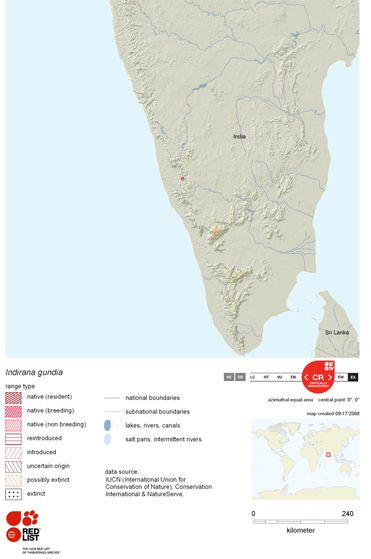
Reptiles: Table 2.10 provides the checklist of the reptiles found in this region. 2 types of lizards and 29 different types of snakes are found in this region contributing to its biological research. The different habitats ranging from evergreen forests to the deciduous forests, grasslands and riparian vegetation proves best niche for most of the rare and some endemic snake species at Gundia and peripheral regions. Snake species like Phipson’s Shieldtail, Montane Trinket Snake, Beddome’s Keelback, Ceylon Cat Snake, Forsten’s Cat Snake, Brown Vine Snake (Figure 2.5), Striped Coral Snake, Beddome’s Cat Snake, King Cobra, Hump Nosed Pit Viper, Bamboo Pit Viper, Malabar Pit Viper are endemic to Western Ghats and are quite well represented in this region. They are quite specific to micro climatic conditions and are dependent on specific habitat.
Table 2.10: Reptiles of Gundia basin
| Sl. |
Scientific Name |
Common Name |
IUCN Status |
| 1. |
Varnus bengalensis (Daudin, 1802) |
Common Indian Monitor Lizard |
VU |
| 2. |
Calotes sp. |
Lizard |
|
| 3. |
Ophiophagus hannah (Cantor, 1836) |
King Cobra |
LRnt |
| 4. |
Naja naja (Linnaeus, 1758) |
Spectacled Cobra |
LRnt |
| 5. |
Hypnale hypnale (Merrem, 1820) |
Common hump-nosed pit viper |
LRnt |
| 6. |
Trimersurus malabaricus (Jerdon, 1853) |
Malabar Pit Viper |
LRnt* |
| 7. |
Echis carinatus carinatus (Schneider, 1801) |
South Indian Saw-scaled Viper |
LRnt** |
| 8. |
Chrysopelea ornata ornata (Shaw, 1802) |
Indian Ornate Flying Snake |
LRnt |
| 9. |
Xenochrophis piscator piscator (Schneider, 1799) |
Water Snake |
Lrlc |
| 10. |
Ahaetulla nasuta (Lacepede, 1789) |
The Vine Snake |
LRlc |
| 11. |
Ptyas mucosus mucosus (Linnaeus, 1758) |
The Rat Snake |
LRnt |
| 12. |
Python molurus molurus (Linnaeus, 1758) |
Python |
LRnt |
| 13. |
Uropeltis phipsonii (Mason, 1888) |
Phipson’s Shield Tail |
|
| 14. |
Python molurus molurus (Linnaeus, 1758) |
Indian Rock Python |
|
| 15. |
Gongylophis conicus (Wagler, 1830) |
Common Sand Boa |
|
| 16. |
Coelognathus Helena Helena (Daudin, 1803) |
Common Indian Trinket snake |
|
| 17. |
Coelognathus Helena monticollaris (Daudin, 1803) |
Montane Trinket snake |
|
| 18. |
Argyrogena fasciolata (Shaw, 1802) |
Banded Racer |
|
| 19. |
Oligodon arnensis (Shaw, 1802) |
Banded Kukri Snake |
|
| 20. |
Lycodon aulicus (Linnaeus, 1758) |
Common Wolf Snake |
|
| 21. |
Sibynophis subpunctatus (Duméril & Bibron, 1854) |
Dumeril’s Black Headed Snake |
|
| 22. |
Xenochrophis piscator (Schneider, 1799) |
Checkered Keelback Water Snake |
|
| 23. |
Amphiesma stolatum (Linnaeus, 1758) |
Buff - Striped Keelback |
|
| 24. |
Macropisthodon plumbicolor (Cantor, 1839) |
Green Keelback |
|
| 25 |
Amphiesma beddomei (Günther, 1864) |
Beddome’s Keelback |
|
| 26. |
Atretium schistosum (Daudin, 1803) |
Olive Keelback |
|
| 27. |
Boiga trigonata (Schneider, 1802) |
Common Indian Cat Snake |
|
| 28. |
Boiga ceylonensis (Günther, 1864) |
Ceylon Cat Snake |
|
| 29. |
Boiga forsteni (Duméril, Bibron & Duméril, 1854) |
Forsten’s Cat Snake |
|
| 30. |
Ahaetulla pulverulenta (Duméril & Bibron, 1854) |
Brown Vine Snake |
|
| 31. |
Daboia russelii (Shaw & Nodder 1797) |
Russel’s Viper |
|
| 32. |
Trimeresurus gramineus (Shaw, 1802) |
Bamboo Pit Viper |
|
Figure 2.5: Brown Vine Snake and Lizard of Gundia river basin
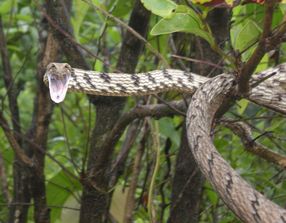 |
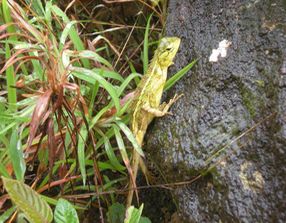 |
Avian Diversity: Ninety one species of birds were found to be present in this region (Table 2.11). The Riparian vegetation of Hongadahalla, Battekumri halla and Kempholé harbours most of the species. Riparian and disturbed Semi-evergreen patches of Hongadahalla area harbour more species. Birds are specific to vegetation and also the topography, though they fly long distances. They are dependent on micro and macro habitat, food, nesting and roosting places, safety. Though they adapt to some extent, they are very much dependent mainly on habitat. 14 species of birds are endemic to Western Ghats. Of these during the current field work, birds like Nilgiri Wood Pigeon, Malabar Parakeet, Rufous Babbler, White Bellied Blue Flycatcher, Malabar Grey Hornbill were sighted in Gundia and peripheral regions. Hornbills like Malabar Hornbill and Great Pied Hornbill; woodpeckers like Lesser Golden Backed Woodpecker, Great Black Woodpecker, Heart Spotted Woodpecker; Owls like Great Horned Owl, Mottled Wood Owl, Jungle owlet and several tree dependent species nests in large tree holes. They prefer old and large trees to scoop the bark and nest. Several birds are quite important for seed dispersal like the Hornbills for dispersing Myristica malabarica, Dillenia pentagyna, Ficus species seeds to distant areas. These seeds when defecated by birds will sprout well. Many smaller nectar birds like sunbirds are dependent on nectars of flowers, hence helps in pollination. Several species of woodpecker, barbets help in maintaining healthy woody trees by feeding on stem boring insects, termites etc. One of the near threatened birds which is endemic to Western Ghats – the Malabar pied hornbill (Anthracoceros coronatus) protected under schedule III of WPA 1972was observed in the region. Indian peafowl (Pavo Cristatus) which belongs to the Scheduled I of protected animals according to the Wild life protection act 1972 was observed in the region.
Table 2.11: Birds found in Gundia basin
| Sr.No. |
Scientific Name |
Common Name |
IUCN Status |
| 1. |
Phalacrocorax niger (Vieillot) |
Little Cormorant |
LC |
| 2. |
Lardeola grayii (Sykes) |
Paddy bird or Pond Heron |
LC |
| 3. |
Falco tinnunculus L., |
Kestrel |
LC |
| 4. |
Gallus sonneratti Temminck |
Grey Jungle fowl |
|
| 5. |
Amaurornis phoenicurus (Pennant) |
White breasted Water hen |
LC |
| 6. |
Streptopelia chinensis (Scopoli) |
Spotted Dove |
LC |
| 7. |
Chalcophaps indica (L.,) |
Emerald Dove |
LC |
| 8. |
Psittacula cyanocephala (L.,) |
Blossom headed Parakeet |
LC |
| 9. |
Apus affinis (J.E. Gray) |
House Swift |
LC |
| 10. |
Halcyon smyrnensis (L.,) |
White breasted Kingfisher |
LC |
| 11. |
Merops orientalis Lantham |
Small Green Bee-eater |
LC |
| 12. |
Anthracoceros coronatus (Boddaert) |
Malabar Pied Hornbill |
NT |
| 13. |
Buceros bicornis (L.) |
Great pied Hornbill |
NT |
| 14. |
Ocyceros griseus (Latham) |
Malabar grey hornbill |
LC |
| 15. |
Psittacula columboides (Vigors) |
Malabar parakeet |
LC |
| 16. |
Cyornis pallipes (Jerdon) |
White bellied blue flycatcher |
LC |
| 17. |
Dryocopus javensis (Horsfield) |
Great black woodpecker |
LC |
| 18. |
Megalaima zeylanica (Gmelin) |
Large Green Barbet |
LC |
| 19. |
Dinopium benghalense (L.,) |
Lesser Golden backed Woodpecker |
LC |
| 20. |
Columba elphinstonii (Skyes) |
Nilgiri wood pigeon |
Vu |
| 21. |
Dicrurus paradiseus (L.,) |
Racket-tailed Drongo |
LC |
| 22. |
Acridotheres tristis (L.,) |
Indian Myna |
LC |
| 23. |
Dendrocitta vagabunda (Lantham) |
Tree Pie |
LC |
| 24. |
Corvus macrorhynchos Wagler |
Jungle Crow |
LC |
| 25. |
Chloropsis cochinchinensis (Gmelin) |
Gold mantled Chloropsis |
LC |
| 26. |
Irena puella (Lantham) |
Fairy Bluebird |
LC |
| 27. |
Pycnonotus cafer (L.,) |
Red vented Bulbul |
LC |
| 28. |
Hypsipetes indicus (Jerdon) |
Yellow browed Bulbul |
|
| 29. |
Rhopocichla atriceps |
Black headed Babbler |
LC |
| 30. |
Terpsiphone paradisi (L.,) |
Paradise Flycatcher |
LC |
| 31. |
Zoothera citrine cyanotus Lantham |
White throated Ground Thrush |
|
| 32. |
Monticola cinclorhynchus (Vigors) |
Blue headed Rock Thrush |
LC |
| 33. |
Motacilla flava L., |
Yellow Wagtail |
LC |
| 34. |
Nectarinia zeylonica (L.,) |
Purple rumped Sunbird |
LC |
| 35. |
Pycnonotus priocephalus (Jerdon) |
Grey headed bulbul |
NT |
| 36. |
Lonchura malacca (L.,) |
Black headed Munia |
LC |
| 37. |
Bubo virginianus (Gmelin) |
Great horned Owl |
LC |
| 38. |
Strix ocellata (Lesson) |
Mottled wood owl |
LC |
| 39. |
Glaucidium radiatum (Tickell) |
Jungle Owlet |
LC |
| 40. |
Francolinus pondicerianus |
Grey partridge |
LC |
| 41. |
Dicrurus leucophaeus |
Ashy drongo |
LC |
| 42. |
Muscicapa dauurica |
Asian brown flycatcher |
LC |
| 43. |
Megalaima zeylanica |
Brown-headed Barbet |
LC |
| 44. |
Acrocephalus dumetorum |
Blyth’s Reed Warbler |
LC |
| 45 |
Loriculus vernalis |
Indian Lorikeet |
LC |
| 46. |
Merops orientalis |
Small Green Bee-eater |
LC |
| 47. |
Dicrurus caerulescens |
White-bellied Drongo |
LC |
| 48. |
Streptopelia chinensis |
Spotted Dove |
LC |
| 49. |
Sitta frontalis |
Velvet-fronted Nuthatc |
LC |
| 50. |
Eudynamys scolopacea |
Asian Koel |
LC |
| 51. |
Milvus migrans |
Black kite |
LC |
| 52. |
Temenuchus pagodarum |
Brahminy Starling |
|
| 53. |
Carpodacus erythrinus |
Common Rosefinch |
LC |
| 54. |
Accipiter trivirgatus |
Crested Goshawk |
LC |
| 55. |
Chalcophaps indica |
Emerald Dove |
|
| 56. |
Chloropsis aurifrons |
Gold-fronted Chloropsis |
LC |
| 57. |
Tringa ochropus |
Green Sandpiper |
LC |
| 58. |
Cuculus micropetus |
Indian Cuckoo |
|
| 59. |
Ardeola grayii |
Indian Pond Heron |
LC |
| 60. |
Acridotheres fuscus |
Jungle Myna |
LC |
| 61. |
Ardeola striatus |
Little green Heron |
|
| 62. |
Sturnus blythii |
Malabar White-headed Starling |
|
| 63. |
Ducula badia |
Mountain Imperial-Pigeon |
LC |
| 64. |
Copsychus saularis |
Oriental Magpie-Robin |
LC |
| 65. |
Cypsiurus parvus |
Palm Swift |
LC |
| 66. |
Psittacula cyanocephala |
Plum headed parakeet |
LC |
| 67. |
Hirundo daurica |
Red-rumped Swallow |
LC |
| 68. |
Vanellus indicus |
Red-wattled lapwing |
LC |
| 69. |
Nectarinia minima |
Small Sunbird |
LC |
| 70. |
Scolopax rusticola |
Woodcock |
LC |
| 71. |
Nycticorax nycticorax |
Chestnut Bittern |
LC |
| 72. |
Haliaster indus |
Brahminy kite |
|
| 73. |
Corvus macrorhynchos |
Jungle crow |
|
| 74. |
Tachybaptus ruficollis |
Little grebe |
LC |
| 75. |
Pericrocotus flammeus |
Orange Minivet |
|
| 76. |
Treron pompadora |
Pompadour green pigeon |
LC |
| 77. |
Ficedula albicilla |
Red-throated Flycatcher |
|
| 78. |
Pericrocotus cinnamomeus |
Small minivet |
LC |
| 79. |
Accipiter nisus |
Sparrow-Hawk |
|
| 80. |
Cyornis tickelliae |
Tickell’s Blue-Flycatcher |
LC |
| 81. |
Alcedo atthis |
Small Blue Kingfisher |
LC |
| 82. |
Circus aeruginosus |
Marsh Harrier |
|
| 83. |
Harpactes fasciatus |
Malabar Trogon |
LC |
| 84. |
Arachnothera longirostra |
Little Spiderhunter |
|
| 85. |
Ducula badia |
Mountain Imperial-Pigeon |
LC |
| 86. |
Plain Flowerpecker |
Dicaeum concolor |
|
| 87. |
Anthus hodgsoni |
Oriental (Olive-backed) Tree Pipit |
LC |
| 88. |
Egretta intermedia |
Median egrett |
|
| 89. |
Dendrocygna javanica |
Lesser Whistling Teal |
LC |
| 90. |
Phylloscopus trochiloides |
Greenish Leaf-Warbler |
|
| 91. |
Pavo cristatus |
Indian Peafowl |
LC |
Mammals: Mammalian diversity is quite interesting and unique to the Western Ghats, most of them elusive and is always amongst the thick wooded region. The Nilgiri Martin, Travancore Flying Squirrel, Common Flying Squirrel, Indian Civet, Palm Civet, Slender Loris being mostly either nocturnal or elusive, quite specific to the wooded regions of Western Ghats. Similarly Royal Bengal Tiger, Sloth Bear, Indian Bison, Leopard, Barking Deer, Indian Mouse Deer, Asian Elephant, Wild Dog, Lion Tailed Macaque, Pangolin, Porcupine are habitat dependent animals and are not well adaptive with slightest disturbances. Many of them like Asian Elephant, Leopard, Tiger, Sloth Bear, Indian Bison stray out and reasons for man-animal conflict. Most of the above species are protected under schedule 1 of WPA 1972. Lion Tailed Macaques are quite elusive but very much social animal, living in troops on trees, feeding on Dillenia pentagyna, Myristica malabarica, Ficus species etc. Several patches of Reeds, Bamboos, Ficus trees, Jackfruit attracts elephants more as they are their favourite fodder. They raid crops when these patches are being denuded or cut down and habitat fragmentation. Due to reduction in grazing patches, several grazing animals like the Indian Bison stray out to crop fields and plantation, resulting in man animal conflict. Tiger straying into the human habitation is mainly due to less availability of prey animals and also the fragmented habitats.
Table 2.12: Mammals of Gundia basin
| Sl. No. |
Scientific Name |
Common Name |
Status |
| 1. |
Bos gaurus (H. Smith, 1827) |
The Gaur |
Vu |
| 2. |
Cervus unicolor (Kerr, 1792) |
Sambar |
LRlc |
| 3. |
Elephas maximus L., 1758 |
Asian Elephant |
Vu |
| 4. |
Felis chaus (Schreber, 1777) |
Jungle Cat |
LRnt |
| 5. |
Petinomys fuscocapillus (Jerdon, 1847) |
Travancore Flying Squirrel |
Vu |
| 6. |
Funambulus palmarum Linnaeus |
Three-striped Palm Squirrel |
LRlc |
| 7. |
Herpestes edwardsi (E. Geoffroy Saint-Hilaire, 1818) |
Common Indian Mongoose |
LRlc |
| 8. |
Hystrix indica (Kerr, 1792) |
Indian Porcupine |
LRlc |
| 9. |
Lepus nigricollis (F. Cuvier, 1823) |
Black-naped Hare |
LRlc |
| 10. |
Macaca radiata (E. Geoffroy, 1812) |
Bonnet Macaque |
LRlc |
| 11. |
Macaca silenus (Linnaeus, 1758) |
Lion tailed Macaque |
En |
| 12. |
Manis crassicaudata (Gray, 1827) |
Indian Pangolin |
LRnt |
| 13. |
Melursus ursinus (Shaw, 1791) |
Sloth Bear |
Vu |
| 14. |
Loris lydekkerianus malabaricus |
Sender Loris |
NT |
| 15. |
Muntiacus muntjak (Zimmermann, 1780) |
Barking deer |
LRlc |
| 16. |
Panthera pardus (Linnaeus, 1758) |
Leopard |
|
| 17. |
Panthera tigris (Linnaeus, 1758) |
Tiger |
En |
| 18. |
Presbytis entellus (Prater, 1971) |
Hanuman Langur |
LRlc |
| 19. |
Ratufa indica indica (Erxleben, 1777) * |
Indian Giant Squirrel |
Vu |
| 20. |
Sus scrofa cristatus Wagner |
Wild Boar |
LRlc |
| 21. |
Tragulus meminna (Erxleben, 1777) |
Mouse Deer |
LRnt |
| 22. |
Viverricula sp. |
Civet Cat |
|
Some faunal species that are highly endemic and featuring in Red List of IUCN have also been observed in this region and its surroundings. These species have a limited distribution and very less populations and hence, their presence testifies the ecological importance of this region too. The details of such species is described here:
- Lion tailed Macaque - Macaca silenus, commonly known as Lion-tailed macaque, is categorized as Endangered by the IUCN Red List and is endemic to the rainforests of the Western Ghats. This belongs to the Scheduled I of protected animals according to the Wild life protection act 1972. Habitat loss and fragmentation has seriously affected this species (Karanth, 1992) and its population has declined drastically with its becoming local extinct in some areas. Karanth (1992) has emphasized the importance of lion-tailed macaques as flagship species for the rapidly declining rainforests of this biodiversity hotspot. Karanth (1985) had reported the presence of 4, 1, 6 and 2 groups of lion-tailed macaques in Brahmagiri Wildlife Sanctuary, Pushpagiri Wildlife Sanctuary, Subrahmanya Reserve forests and Sakaleshpur reserve forests. Whereas, Kumara and Sinha (2009) reported the presence of just two groups lion-tailed macaques in Pushpagiri - Subrahmanya region having four and five individuals respectively. Their study shows an overall decline of 69% in the groups of same study areas surveyed by Karanth (1985). Shrinkage and fragmentation of habitat have resulted in sharp decline in lion-tailed macaque populations across the state and thus, they emphasize the need to investigate more areas having these macaque populations and develop conservation strategies for their protection. If this is not done, these macaques may have to face extinction. Figure 2.5 maps the habitat of LTM in Gundia river basin.
Figure 2.5: Lion Tailed Machaque and its Habitat in Gundia River Basin

Lion Tailed Macaque and its Habitat in Gundia River Basin |
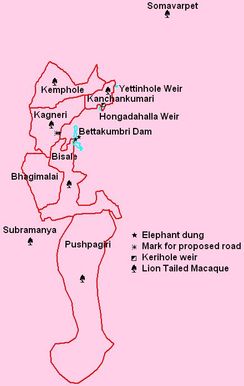 |
- Travancore Flying Squirrel - Petinomys fuscocapillus, commonly known as Travancore Flying squirrel, is one of the small flying squirrel and is expected to be present in some parts of the Western Ghats. This belongs to the Scheduled I of protected animals according to the Wild life protection act 1972. This species was rediscovered from Kerela after a gap of 70 years by Kurup (1989) and after a couple of years it was reported from Indira Gandhi Wildlife Sanctuary in Tamil Nadu by Umapathy (1998). However, there were no sight records of this squirrel from Karnataka state until Kumara and Singh (2005a) reported it from Makut Reserve forests and later Kumara (2007) reported it from Pushpagiri Wildlife Sanctuary and Shravathi Valley Wildlife Sanctuary. All the sightings were from western foot hills and slopes of Western Ghats, having high rainfall and humidity. This species has been accredited as Vulnerable by the IUCN Red List and requires more study and conservation strategies.
- Slender Loris - Slender lorises in India have two sub-species namely Loris lydekkerianus lydekerrianus which prefers drier form of habitat and other Loris lydekkerianus malabaricus which prefers the wet form of habitat. L. lydekkerianus malabaricus is commonly known as Malabar Slender Loris and is found in the rainforest of Western Ghats (Kumar et.al., 2006). Slender lorises are small, often solitary and nocturnal. The Slender Lorises of India are assigned to the category of Near Threatened by IUCN Red List of Threatened Species and have been assigned highest level of protection under Schedule I, of Indian Wildlife Protection Act, 1972. Kumara (2007) has recorded the sightings of Slender Loris in Pushpagiri Wildlife Sanctuary (Figure 2.6).
Figure 2.6: Slender Loris and its distribution in Karnataka (via Gundia basin) [Source: Kumara (2007)]
- Tiger - The Indian Tiger, Panthera tigris, is a very powerful symbol (keystone species) associated with different cultures around the world. However, in last many years it has been extensively hunted and captured leading to a sharp decline in the population across the world especially in India. It has been regarded as endangered to critically endangered in the IUCN Red List and lot of agencies and people have been working for its conservation. This Keystone species belongs to the Scheduled I of protected animals according to the Wild life protection act 1972. Tigers require a large habitat to fulfill their needs but due to habitat fragmentation they are left with limited resources and often encounter human settlements leading to human-tiger conflicts. The presence of tiger pug marks in Bisle Reserve forest and cases of cattle attack in nearby areas points to the presence of tiger in this area indicating this area to be ecologically sensitive and requiring conservation (Figure 2.7).
Figure 2.7: Tiger Corridor (map on LHS) and Pugmark of a Tiger (Right side photograph -pugmark substantiates its presence in the Gundia river basin), Cattle killed by a tiger in Bisle area
- Land snail - The genus Indrella is monotypic. Indrella ampula an endemic species (Figure 2.8) of the Central Western Ghats were sighted in Gundia river basin (wet forest patches of Yetinhalla dam site, Mallali waterfalls). It prefers wet habitat and reported earlier on slopes of Anamalai and Nilgiri ranges and in Waynad region. This species also exhibits colour polymorphism. Its presence highlights the biodiversity significance of the region.
Figure 2.8: Indrella ampula – a land snail pleading KPCL not to submerge its habitat
- Grey headed Bulbul - The Grey headed bulbul, Pycnonotus priocephalus, is a poorly known endemic species to the Western Ghats (Balakrishnan, 2008). It has a very limited distribution and is usually found in high rainfall areas. It is categorized as Near Threatened by IUCN Red List for Threatened species. The presence of this bird was recorded in Brahmagiri and Subrahmanya Reserve forests (Mudappa & Shankar Raman, 2008).
- Nilgiri marten - Martes gwatkinsii, commonly known as the Nilgiri marten (Figure 2.9) is one of the largest and rarest Indian mustelids and is endemic to the Western Ghats. Mudappa (1999) has reported that it prefers moist and tropical rainforests with an altitude of 300 - 1200 m as its habitat. The marten is legally protected under the Wildlife Protection Act 1972 (schedule II), is listed on Appendix-III of the Convention of Trade in Endangered Species (CITES) and is categorized as Vulnerable by IUCN Red List. However, habitat destruction, fragmentation and hunting of Nilgiri marten are hurdles in its conservation. The presence of Nilgiri marten has been reported in Brahmagiri Wildlife Sanctuary by Schreiber et.al. in 1989. Figure 2.9 is the photograph of Nilgiri Marten in Bisle forest.
Figure 2.9: Nilgiri marten
- Malabar pied Hornbill - The Malabar pied Hornbill, Anthracoceros coronatus, is distributed in the forests of India and Sri Lanka. This species is frugivorous (Reddy et.al. 1990) and is found to be occurring in mixed deciduous, riparian and moist deciduous forests. It has been classified as Near Threatened by IUCN Red List of Threatened Species. This bird species was reported by Gururaja et.al. from Gundia river catchment area. This belongs to the Scheduled I of protected animals according to the Wild life protection act 1972.
- Elephant - The elephants occupy very large areas and are regarded as ‘Umbrella species’ because if they are conserved, a lot of other species occupying that same area will also be conserved. They are also regarded as premier ‘Flagship species’ and sometimes also called ‘Keystone species’ because of their important role in ecology and environment. The Asian elephants have been described as endangered by the Wildlife Protection Act, 1972 (Appendix-1) and by Appendix 1 of the Convention of International Trade of Endangered Species of Flora and Fauna (CITES) in 1975. The Mysore Elephant Reserve was notified by the Karnataka Government in November, 2002. It covers the total area off 6,724 sq.km. The Bisle Reserve Forest of Gundia Basin, vide the said GO (FEE 231 FWL 2000, 25/11/2002), constitutes a vital part of the Mysore Elephant Reserve. It covers an area of 3,339 ha(survey details). It adjoins Kempholé Reserve Forest in north and Pushpagiri Wildlife Sanctuary in the south. It is an integral and important part of the Mudumalai – Nagarholle – Brahmagiri – Mathodi Corridor (Figure 2.10, LHS) and Nagarhole – Malambi – Dodabetta – Hemavati Migratory Path (Figure 2.10, Right Hand Side –RHS)
Figure 2.10: Gundia river basin is an integral part of Elephant Corridror
Annexure I provides the people’s biodiversity register of Hongadahalla village panchayath, which further substantiates the bioresource’s diversity and richness
|